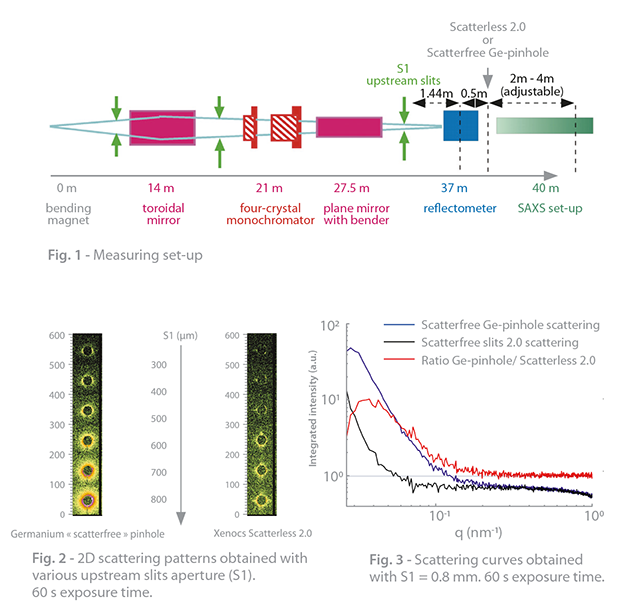Xenocs new generation of Scatterless slits 2.0 is compared to other existing commercial solutions available for beam collimation with low parasitic scattering.
Introduction
One of the most difficult problems to solve in a SAXS system is how to suppress the parasitic signal close to the direct beam. Xenocs Scatterless slits 2.0 practically eliminate parasitic scattering, leading to enhanced resolution and flux. Comparison with a commercially available Germanium scatterfree pinhole has been performed at a synchrotron facility and demonstrates the Scatterless slits 2.0 performance.
Measurements & results
Tests were conducted at the PTB four-crystal monochromator beamline at BESSY II, in Berlin, Germany, using 8 keV radiation. The tested apertures were aligned into the primary beam to allow a maximum photon flux. Comparative measurements between the commercially available scatterfree Ge-pinhole and Scatterless slits 2.0, were performed sequentially. In order to study the influence of photon flux on cleaning capabilities, the beam size was systematically varied using the S1 upstream slits (see Figure 1). In the aim to get faithful comparison, the size of Scatterless slits 2.0 was set to 0.9 mm to obtain the same downstream photon flux as with the commercially available Ge-pinhole of 1 mm.
The comparative measurements are displayed in Figure 2. These 2D patterns1 show that the performance of the Scatterless slits 2.0 is higher than that of the commercially available Ge-pinhole, regardless of the beam opening value. Comparison of the 1D scattering curves obtained from the 2D patterns is displayed in Figure 3. In the measured q_range [0.04-0.4] nm-1, scattering from the Scatterless slits 2.0 remains lower than that of the scatterfree Ge-pinhole. One can even notice a ratio up to 10 in favor of the Scatterless 2.0 slits at low qmin value (0.04 nm-1).
To go further
Application fields, such as characterization of diluted systems, ie BioSAXS, require high signal-to-noise ratio (I/?) at every q values, to ensure improved buffer subtraction for accurate data analysis. In the same way, investigation of large nanostructures with weak scattering power involves high resolution collimation which impacts useful flux on sample. For such demanding applications, high I/? at low qmin is mandatory, and increasing such factor provides a direct improvement in data quality.
The use of low scattering slits contributes to improve the signal-to-noise ratio. The Scatterless slits 2.0 are fully integrated in the new generation Xeuss 2.0 SAXS/WAXS system. In addition to the increase of performance, Scatterless 2.0 slits enable one to change the SAXS/WAXS system resolution by automatic recall of slits settings through a single software push button action without further intervention.
1 Data courtesy of Dr Michael Krumrey (PTB Berlin, four-crystal monochromator Beamline ; 8 keV radiation)



































